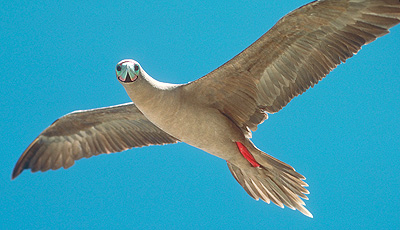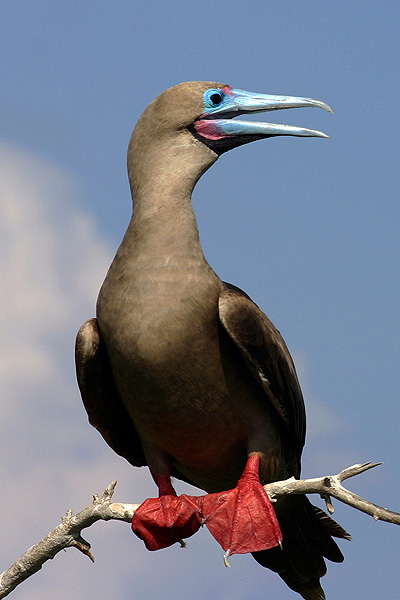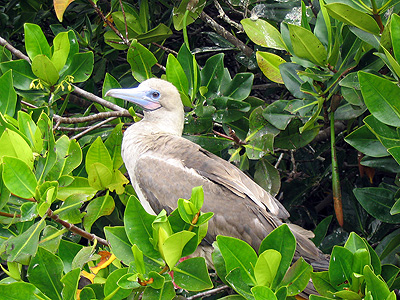The Red Footed Booby is the smallest of the three Galapagos species of boobies, they are semi nocturnal and tends to perch and nest in trees rather than being ground based like the others.
They feed almost exclusively far off shore in the open ocean, often around the submerged bajos or submarine volcanoes where upwelling currents cause a bloom of algae and of fish that feed on them.
Red Footed Booby - Sula sula
Profile - Animals of the Galapagos
There are distinct plumage types or morphs, "brown phase" which are the commonest in the Galapagos, and "white phase" , although there are other birds that are anywhere in-between the two or are almost entirely dark brown. All morphs have red feet and a mainly blue beak.
red footed booby facts - Basics
Weight: 850 - 1000 g (1.7 - 2.2 lbs)
Size: 69 - 79cm (27 - 31 in) long with a wingspan of 1.37 m (4.5 feet)
Breeding: Courtship similar to that of the blue-footed booby but happens in the trees where a nest is made which is a large open platform of twigs lined with leaves and grass and cemented with guano. A single egg is laid which both parents incubate for about 45 days, the chick fledges after another 130 days and is still partially dependent on the parents for another 90 days. The mating pairs may remain together for several seasons. There is no segregation of the different colour morphs, they interbreed freely. Eggs are laid only about every 15 months.
Estimated world population: Global population estimated to around 1,000,000 but declining.
Feeding: They can travel for up to 150 km (93 miles) in search of food. Fish are the main prey in daylight and squid at night which they can see due to their phosphorescence. They catch them by plunge diving throwing back the wings before hitting the water when the nostrils close or may catch flying fish in the air. They swim under water using their strong webbed feet
Conservation status: Least concern, though the population is in decline, the decline is slow.
Distribution: Throughout the Tropics across most oceans bounded by a line slightly north of the Tropics of Cancer and Capricorn.
Predators: There are no predators on the adults other than poaching and egg collecting. The eggs and young are vulnerable to a range of native predators such as snakes, hawks, owls and herons, and non-native species introduced by man such as rats, cats and dogs.
What are Red Footed Boobies Like?

The red-footed booby is more graceful in flight than are the blue-footed and Nazca boobies also found in the Galapagos.
The red feet are usually easy to see to identify these birds, though they may be tucked out of sight in flight and if the bird is a white morph, it could be confused with a Nazca Booby.
Top banner credit - Dick Daniels carolinabirds.org, used under CC3 Attribution Share alike Unported license.




